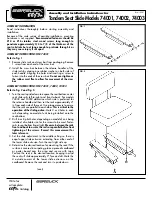
Chapter 14 - Notes on battery use
54
PROFIBUS Tester BC-700-PB - User Manual
Since delayed chemical reaction can occur, it is best to observe the battery as a
safety precaution. Battery observation should occur in a safe area outside of any
building or vehicle and away from any combustible material.
You must not short circuit the wire leads! Never place the cells on a conductive
surface.
Wire lead shorts can cause fire! If you accidentally short the wires, the battery must
be placed in a safe area for observation for approximately 15 minutes. Additionally, if a
short occurs and contact is made with metal (such as rings on your hand), severe
injuries may occur due to conductibility of electric current.
A battery can still ignite even after 10 minutes.
In the event of a crash, you must remove battery for observation and place in a safe
open area away from any combustible material for approximately 30 minutes.
Never store or charge battery pack inside your car in extreme temperatures, since
extreme temperatures could ignite fire. Keep in mind the maximum allowed storage
temperature. Refer to
for more information.
Use caution to avoid puncture of the cell. Puncture of cells may cause fire.
You must not pull the wire leads when you carry or remove the battery from the
device.
In case of cells being damaged, do not use the battery anymore!
You must not open the cells. Oxygen and lithium will heavily react with each other!
If the electrolyte may get in contact with your skin or with our eyes, please give a wash
by using plenty of water and soap and call on a doctor.
Defective lithium ion batteries may evaporate substances which are harmful to
health! You must not inhale!
Please return old battery packs to a recycling center or hand over to us for proper
disposal. You must not ship battery packs which are clearly damaged. Please contact
our support department.
You must not throw battery packs on the fire.
14.2.2 Charging
Use only the wide-range power supply (AC adapter) provided with the tool (see
) in order to charge the battery. Set voltage and current correctly
(failure to do so can cause fire).
Never charge batteries unattended.
Charge in an isolated area, away from other flammable materials.
For operating temperatures while charging refer to
(operating
temperature).
55
8
56







































